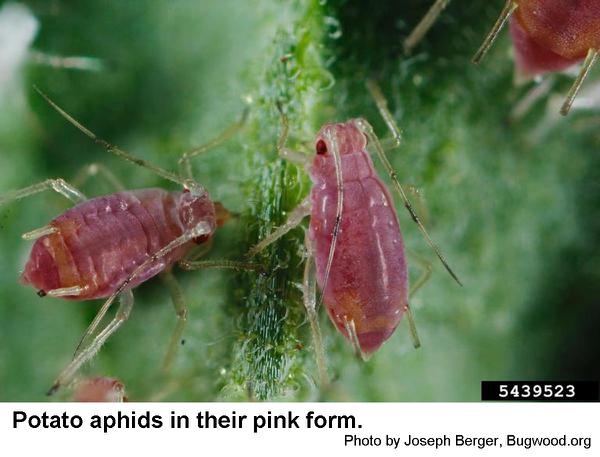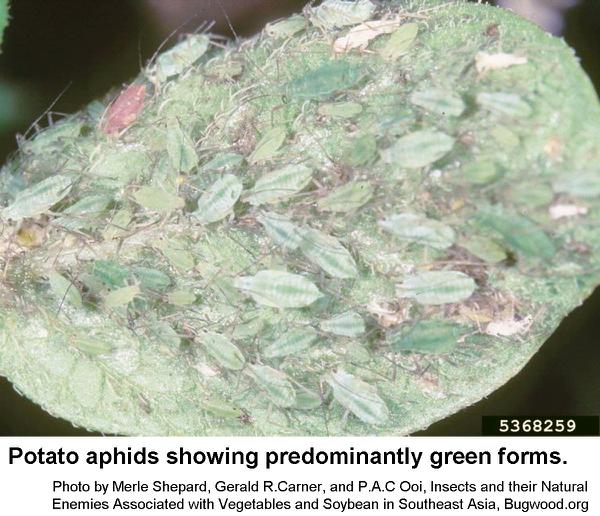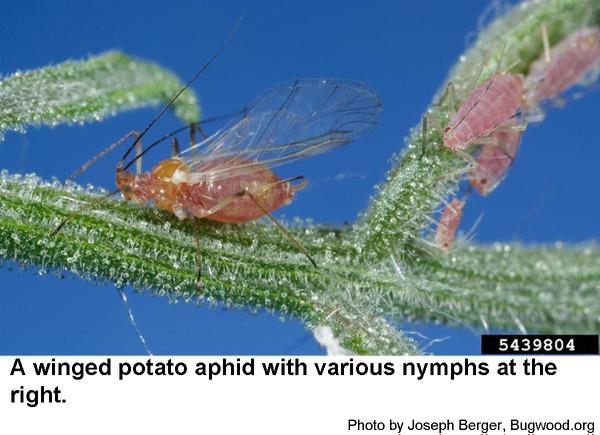Description and Biology
The potato aphid, Macrosiphum euphorbiae, is a fairly large, long-bodied, grayish-green or pink aphid with long legs, antennae and cornicles (slender "tailpipes" that stick out to the rear). Adult females are almost 1/8 inch long. Nymphs are smaller than adults but similar in color and shape. All stages have slender mouthparts and feed by sucking sap from leaves and stems. Rose is the only plant on which potato aphids lay their overwintering eggs. In North Carolina, female potato aphids feed and reproduce year round. No eggs or males are produced. Wingless females give birth to about 50 live nymphs. During warm weather, each of these nymphs matures in two or three weeks. The life cycle continues in this manner until overcrowding occurs or food becomes scarce. At these times nymphs develop into winged adults that migrate to new host plants. Once settled down, these aphids begin reproducing and the life cycle continues as before. During cold weather, however, feeding and reproduction occur at a much slower rate. Many generations are produced each year. When potato aphids settle even for a brief time on ornamental plants, they can transmit viruses including freesia mosaic virus, iris mild virus, iris mosaic virus, iris severe virus, lily symptomless virus, narcissus degeneration (virus), narcissus late season yellows, narcissus white streak virus, narcissus yellow strips virus, Soleil d'Or virus, and tulip breaking virus.
Host Plants
Potato aphids infest rose, lilies, narcissus, freesia, iris, and tulip. It infests the foliage and flowers of tulips, and it causes yellow marks on leaves and stunts the growth of freesia, gladiolus and iris foliage. These aphids also infest vegetable crops and weeds including ragweed, lambsquarter, jimsonweed, pigweed, shepherdspurse, and wild lettuce.
Residential Recommendations
Lady beetles and their larvae, lacewing larvae, and syrphid fly larvae prey upon potato aphids. Most pyrethroid insecticides available for aphid control are highly disruptive of natural enemy populations. Insecticidal soaps, neem seed extracts, or horticultural oils can be considered for aphid management on flowering crops as the impact of these insecticides on biological control agents is much less severe.
References
- Aphids on Ornamental Landscape Plants. Steven Frank. 2009. Entomology Insect Notes, NC State Extension Publications.
- Aphids on the World's Herbaceous Plants and Shrubs, 2 Volume Set. Blackman, R. L. and V. F. Eastop. 2007. 1456 pp. ISBN: 978-0-471-48973-3
- Potato Aphid, Scientific Name, Macrosiphum euphorbiae. Anonymous. No Date. Digital Diagnostics. Oklahoma State University, Entomology & Plant Pathology.
- Potato Aphid on Tomatoes. Kuhar, T., S. Reiter and H. Doughty. 2009. Virginia Cooperative Extension Publications and Educational Resources.
- Potato Aphids, Scientific names: Green peach aphid: Myzus persicae, Potato aphid: Macrosiphum euphorbiae. Godfrey, L. D. and D. R. Haviland. 2016 (revised). How to Manage Pests, UC Pest Management Guidelines. UC IPM.
- Extension Plant Pathology Publications and Factsheets
- Horticultural Science Publications
- North Carolina Agricultural Chemicals Manual
For assistance with a specific problem, contact your local Cooperative Extension Center.
This Factsheet has not been peer reviewed.
Publication date: Sept. 1, 2017
Revised: June 10, 2022
Recommendations for the use of agricultural chemicals are included in this publication as a convenience to the reader. The use of brand names and any mention or listing of commercial products or services in this publication does not imply endorsement by NC State University or N.C. A&T State University nor discrimination against similar products or services not mentioned. Individuals who use agricultural chemicals are responsible for ensuring that the intended use complies with current regulations and conforms to the product label. Be sure to obtain current information about usage regulations and examine a current product label before applying any chemical. For assistance, contact your local N.C. Cooperative Extension county center.
N.C. Cooperative Extension prohibits discrimination and harassment regardless of age, color, disability, family and marital status, gender identity, national origin, political beliefs, race, religion, sex (including pregnancy), sexual orientation and veteran status.




